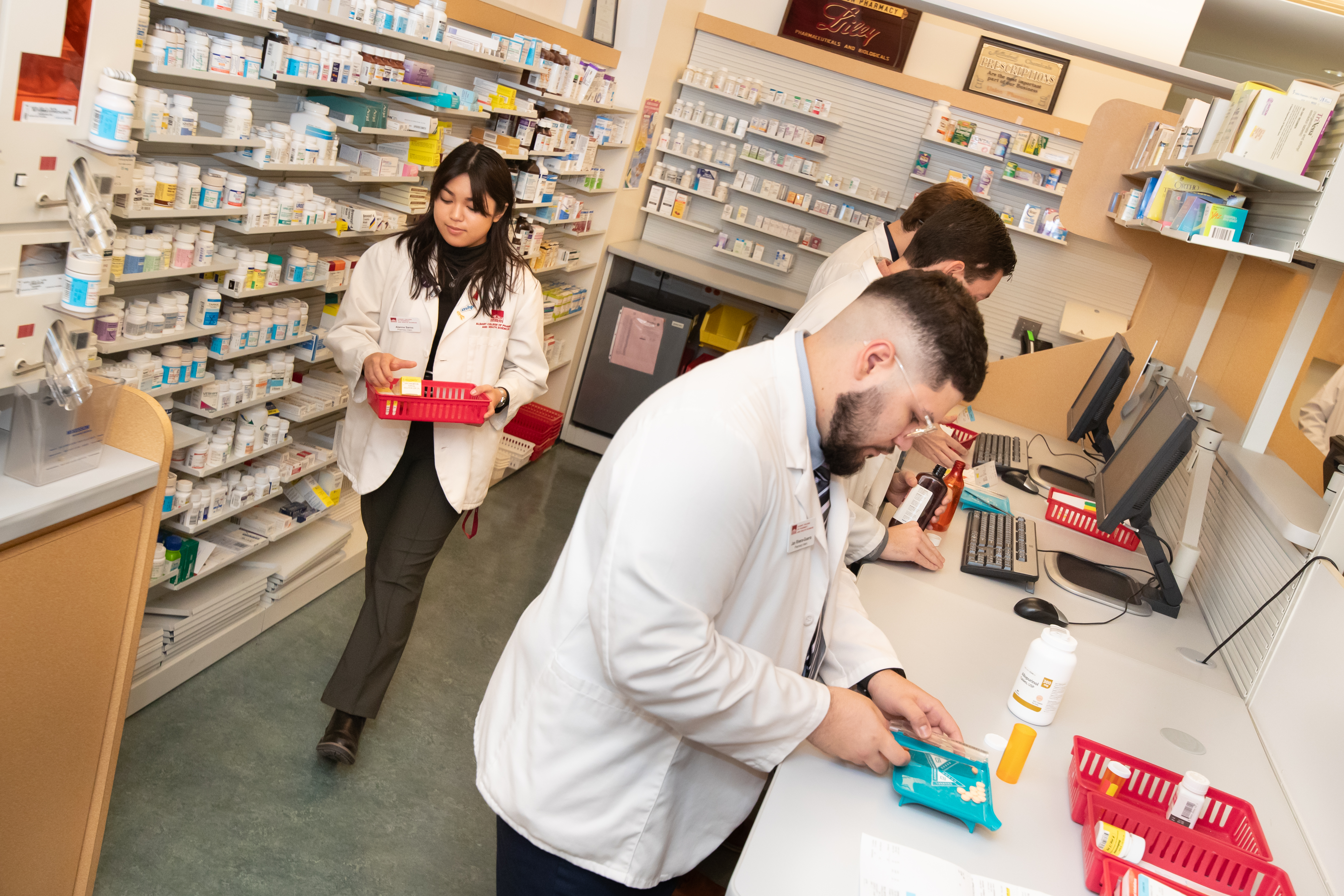
Nearly a century ago, Albany College of Pharmacy students learned to make fizzy beverages — an egg cream, say, or a cherry phosphate — as preparation for work in drugstores.
A soda fountain was part of the ultramodern Union Pharmacy, part of the state-of-the-art school built in 1927. There was also a cash register, as well as a complete line of medicines and chemicals.
Today, computer monitors sit atop the counters, and students are more likely to learn how to instruct a patient to use digital health tools or an automated insulin delivery system. But the purpose behind what is now called the “mock pharmacy” — the oldest registered pharmacy operating in New York — remains the same: to prepare students for careers in modern professional environments.
“It feels like a real pharmacy,” said Jan Rivera-Guerra (pictured above, right), a P2 student who filled his first prescription (for the asthma medication fluticasone) and counseled his first “patient” (he explained how to hold the discus-shaped inhaler like a hamburger) in the mock pharmacy last year. “You get ready to handle any situation you might encounter.”
The pharmacy adjoins the skills lab where students begin work in their first year of professional training (the P1 year). It symbolizes the transition students make from their undergraduate classrooms, said Jonathan Adamec, a P4 student doing a rotation in pharmacy education with pharmacy skills Instructors Andrew Flynn and Dr. Hillary Matson.
“When you step foot in this room, you’re able to step back and say, ‘That’s why I’m doing this, that’s where I’m going,’” Adamec said.
In the mock pharmacy, students are given prescriptions to fill for fictional patients. They practice with real medications that may be tablets or capsules, inhalers or eyedrops, and learn how the drugs are typically organized on pharmacy shelves. They log onto computers to review prescriptions and learn how to document their own notes so that other medical professionals can refer to them. They decode arcane abbreviations (“ac” for before meals, “ad” for right ear) known as Sig codes (from a Latin word meaning “let it be labeled”) and translate those medication instructions onto easy-to-read labels for patient reference. They ultimately counsel a person pretending to need the medication.
P2 student Alanna Sarno (pictured, walking) started working at a chain pharmacy just as she was getting experience at the mock pharmacy. The technologies and specific processes were a little different at each place, but the workflow was similar.
“It definitely exposes you to different pathways that could be put into use,” she said.
For Alec Williams, another P4 student on rotation in the skills lab, the most important training in the mock pharmacy was how to talk on the phone. What did the GenZ student, raised on texts and emails, learn specifically? He held his hand with thumb and pinky extended near his ear. “Not to pick up and just say, ‘What’s crack-a-lacking,’ because that’s unprofessional,” he quipped.
Seriously, once you get past, “How can I help you?”, learning how to communicate with a patient who may have a hard time understanding their medications, without the benefit of body language or facial expressions, is a crucial skill for a pharmacist. As is talking to a doctor who has ordered a medication that needs adjusting. It’s all part of the training in the mock pharmacy.
The ultimate value of gaining experience there is that it helps future pharmacists learn the basics and establish workplace routines so they can focus on what’s important when they reach their rotations in actual pharmacies.
“You want the focus to be on the patient,” Adamec said, “not on, where do you find the drug, how do you use the computer?”

Union Pharmacy, circa 1934

